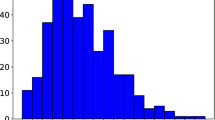Abstract
From two independent normal populations with unknown means and a common known variance, samples of unequal sizes are observed at stage 1. The goal is to find that population with the larger mean. Using the Bayes approach, optimum allocations ofm additional observations, at stage 2, are derived under the linear and the 0–1 loss.
Similar content being viewed by others
References
Abughalous, M. M. and Miescke, K. J. (1989). On selecting the largest success probability under unequal sample sizes.J. Statist. Planning and Inference,21, 53–68.
Bechhofer, R. E. (1969). Optimal allocation of observations when comparing several treatments with a control. In:Multivariate Analysis II, P. R. Krishnaiah ed., Academic Press, New York, 465–473.
Bechhofer, R. E., Hayter, A. J. and Tamhane, A. C. (1991). Designing experiments for selecting the largest normal mean when the variances are known and unequal: Optimal sample size allocation.J. Statist. Planning and Inference,28, 271–289.
Berger, J. O. (1985).Statistical Decision Theory and Bayesian Analysis. Second Edition. Springer Verlag, New York.
Berger, J. O. and Deely, J. (1988). A Bayesian approach to ranking and selection of related means with alternatives to AOV methodology.J. Amer. Statist. Assoc.,83, 364–373.
Dudewicz, E. J. and Dalal, S. R. (1975). Allocation of observations in ranking and selection with unequal variances.Sankhyā,B-37, 28–78.
Gupta, S. S. and Miescke, K. J. (1988). On the problem of finding the largest normal mean under heteroscedasticity. In:Statistical Decision Theory and Related Topics IV, S. S. Gupta and J. O. Berger eds., Springer Verlag, New York, Vol. 2, 37–49.
Gupta, S. S. and Panchapakesan, S. (1991). Sequential ranking and selection procedures. In:Handbook of Sequential Analysis, B. K. Ghosh and P. K. Sen eds., M. Dekker, New York, 363–379.
Gupta, S. S. and Panchapakesan, S. (1979).Multiple Decision Procedures: Theory and Methodology of Selecting and Ranking Populations. J. Wiley, New York.
Author information
Authors and Affiliations
Additional information
Research supported in part by NSF Grant DMS-8923071 at Purdue University.
Rights and permissions
About this article
Cite this article
Gupta, S.S., Miescke, K.J. Bayesian look ahead one stage sampling allocations for selecting the largest normal mean. Statistical Papers 35, 169–177 (1994). https://doi.org/10.1007/BF02926410
Received:
Revised:
Issue Date:
DOI: https://doi.org/10.1007/BF02926410



